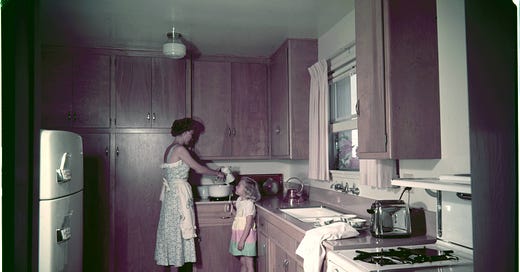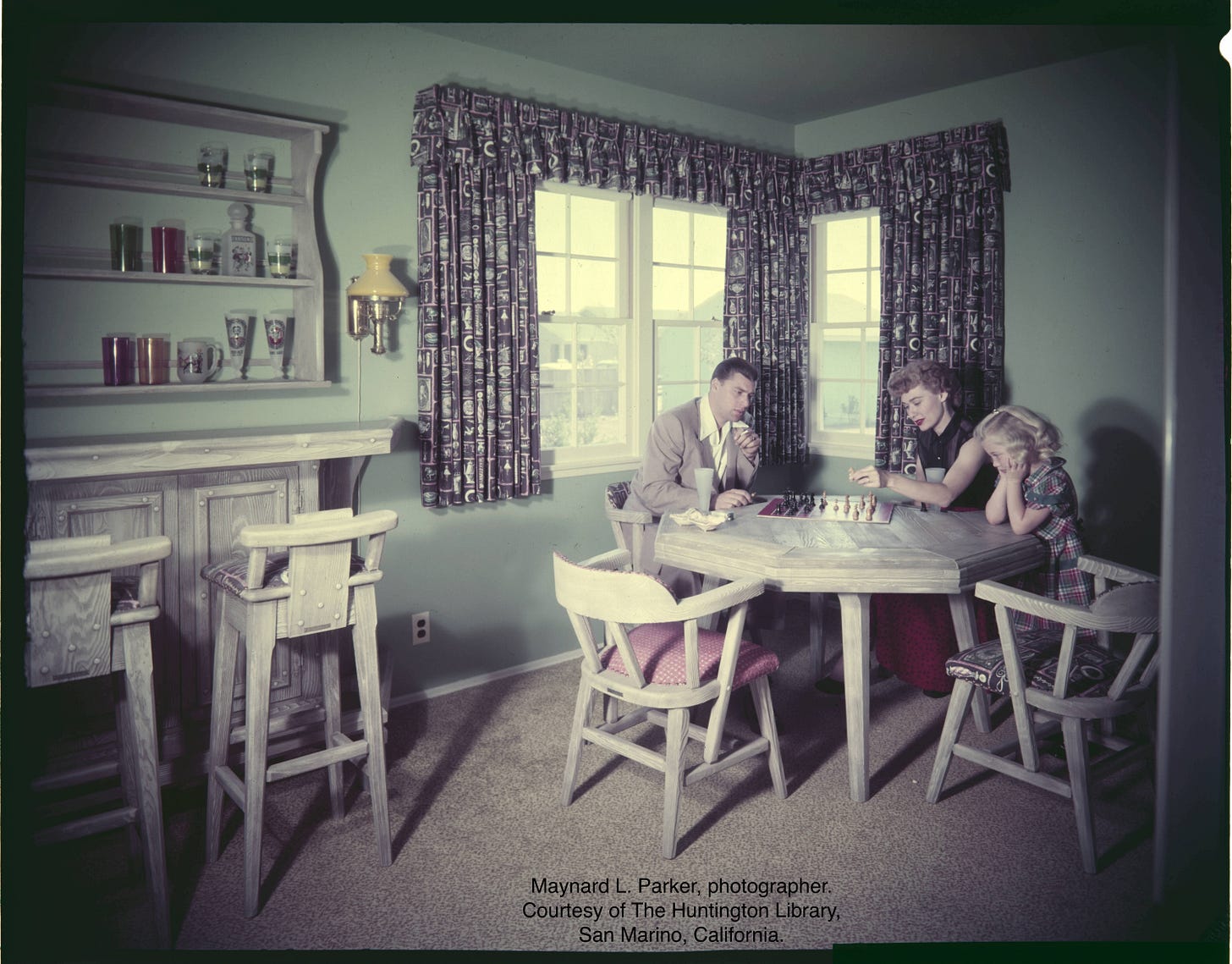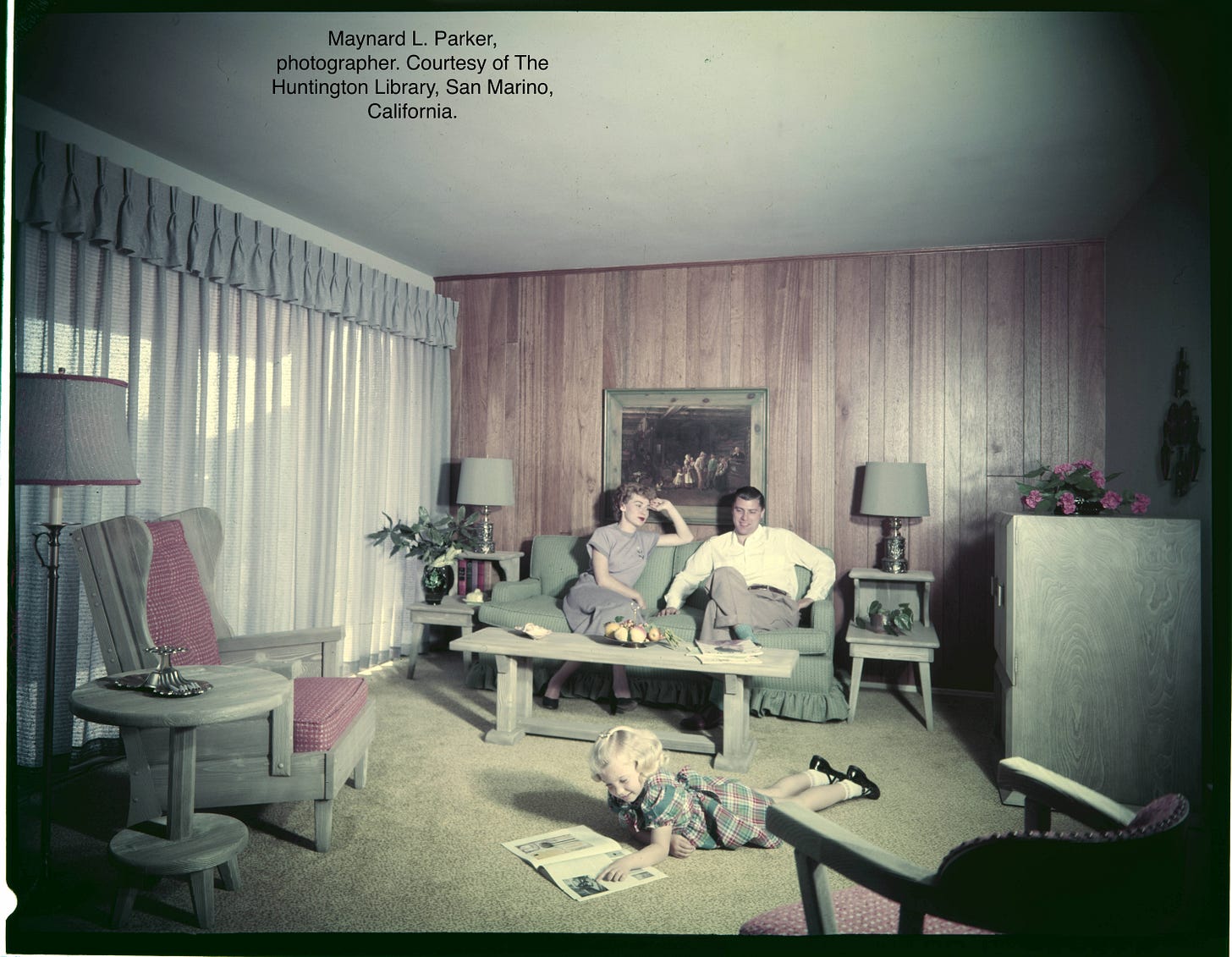“It’s only costing me very little extra each month and it’s going to keep my wife comfortable during the hottest days of the summer…I think she’ll appreciate this more than anything else I might give her for Christmas.”
-Junius Waltham on gifting his wife an air conditioner, 19561.
Long before the Valley Girl2 was depicted as a white 1980s airhead or a middle-class sex worker, she was propaganda for the growing housing market of the San Fernando Valley. During the 1950s and 1960s, the Valley Girl was commercially crafted to sell a specific perception of new, quaint suburban living in Southern California. And, even more pointedly, to sell property to white patriarchs.
Archival material from this time illuminates how the modern inception of the Valley was anchored in middle-class aspirations, particularly for white Americans. The utopian dream of the San Fernando Valley was communicated through both fluffy media reports and advertisements for “affordable” luxury. “Good,” white women and girls, more specifically the Valley Girl, were a prominent character of that fantasy.
During the 1950s and 1960s, the Valley Girl was commercially crafted to sell a specific perception of new, quaint suburban living in Southern California.
A 1956 piece from the Los Angeles Sentinel, headlined “Man, This Is Really Living! Says New Pacoima Resident,” lays out an enthusiastic testimonial by a husband and father who has been living in Pacoima Park Estates3 for three months. The reportedly $4 million dollar housing development is located in “the heart of the San Fernando Valley” and said father, Maxwell Bragish, is absolutely pumped about his new suburban living situation. His new home, which he shares with his wife, Josanne, and their three children, is described as “brand-new, spic and span” and contains three “spacious” bedrooms, a second bathroom, and a family room for “informal entertaining and every-day family living.” The new home is presented as modern and even enviable, while still preserving the needs of the traditional family—an enduring formula for selling Valley life during this time:
“Showing his house with the pride of new ownership, [B]ragish pointed out the sliding glass wall connecting living room with patio area, the ranch style open beam ceilings, the spacious modern kitchen with natural ash cabinets, built-in serving snack bar, rose-colored sink and comfortable breakfast nook.
Other features mentioned by him included hardwood doors throughout, all aluminum sliding windows and the costly crushed rock roofing. ‘That’s the best insulating material there is,’ [Bragish] said. ‘It kept the house nice and cool during that hot spell we had a couple of weeks ago. Incidentally, I understand the new units going up have air conditioning.’”4
This “advertorial” for middle-class Valley living is further bolstered by a quote by Josanne, speaking to the social standards of the area: “Mrs. Bragish is equally happy with her new home. ‘Schools, shopping, and church are all close by,’ she commented. ‘And it’s very nice to have a yard all your own. We have a total of 9400 sq. ft.’”
Having a new-to-the-area wife and mother cite education, consumerism, and God was the holy trinity for developers trying to sell the idea of 1950s white suburban living. To be in close proximity to all three is an official sanction for those curious about what the Valley has to offer a family like theirs. And while the husband can brag about “insulating material” and the solid craftsmanship of the house itself, having the wife accredit the morality of the surrounding area is particularly impactful to this lifestyle vision. It’s her assessment, specifically as a mother and wife, that elevates the piece beyond a flat advertisement for crushed rock roofing.
Many other newspaper reports from this time period stress the details of “luxury” living—a brand new home on a pretty piece of land for next to nothing, and in a “new” community just a 20-minute drive away from glamorous Los Angeles. There are endless open houses, record sales of entire neighborhoods, and chirpy quotes from deliriously happy husbands and wives about appliances like air conditioning.
There were a lot of man-made communities like this in the 1950s and 1960s; white, middle-class havens in which to exercise aggressive normalcy. And the “new” women of these areas needed to be upheld as representing these ideals: commerce, church, traditional families and gender roles, classism, and conventional, white femininity.
The way this standard was applied to local women and girls was both as narrow and homogenous as the communities being cultivated. Valley Girls were presented as uniformly feminine and subservient, which was the standard for white middle-class women in the 1950s. They were economically comfortable stay-at-home mothers and wives who did not have interests5 outside the needs of their husband, children, and home.
It’s in this time period of mass white land grab and rose-colored kitchen sinks that the term “Valley Girl” first enters the mainstream press. The earliest citing I’ve been able to find so far6 is from 1962: the Los Angeles Times published a short item headlined “Valley Girls Dine Out”7 reporting on a few women from the Valley (and of some social standing, it seems), going to a local restaurant in Panorama City. (These valley girls8 are reportedly from Reseda, Northridge, North Hollywood, and San Fernando, respectively.)
This early article establishes from the outset that Valley Girls carry an air of respectability about them: they dine out and they are newsworthy— elevated by the press as aspirational. What you want for your middle-class life is a Valley Girl.
It’s in this time period of mass white land grab and rose-colored kitchen sinks that the term “Valley Girl” first enters the mainstream press.
Local publications would continue to inform the public that “Valley Girls” were attentive mothers, eager to better their domestic skills9, and even win beauty pageants. A 1963 piece entitled “Valley Girls Seek Crown”10 announces that a solid half of the 30 finalists who would appear in the upcoming Miss Los Angeles County beauty pageant were girls from the Valley. Another article from 1969 reports that two valley girls were among those making their debut at a 13th annual debutante ball (“Janice Gail Rudof, daughter of Mr. and Mrs. Joel Rudof of Encino, and Linda Kay Hathaway, whose parents are Mr. and Mrs. James Hathaway of Studio City…”11), their full-length pictures prominently printed along side the story, capturing the extent of their finery.
The deb ball story adds another important dimension: in addition to being hotties who can cook, Valley Girls are also assured to be from “good” families, assuaging any class anxieties. These are the “right” women from the “right” backgrounds for you and your family.
The story the press tells again and again is unwavering: Valley Girls are an essential part of this nuclear, suburban fantasy. As fundamental to these fantastic new houses as the natural ash cabinets.
Local publications would continue to inform the public that “Valley Girls” were attentive mothers, eager to better their domestic skills, and even win beauty pageants.
This storytelling—across newspapers, ads, and narratives—was geared toward engaging the imagination (and aspiration) of white cis het men and getting them to spend accordingly. Think Maxwell Bragish types and all his friends back in cramped apartments in Los Angeles proper or in the Midwest, tired of the brutal winters.
Some of this Valley fantasy appears to have successfully taken root in teen center meetups, debutante balls, and parades. For a moment, there seems to have been a truly engaged and celebrated white community. And then the Fair Housing Council of the San Fernando Valley would come, and ruin it.
Next week: say hey to the KKK.
“Air Conditioning for Wife’s Christmas Gift.” Los Angeles Sentinel, 13 Dec. 1956, p. C10.
Uppercase “Valley Girl” to indicate the manufactured caricature.
Pacoima is considered one of the oldest neighborhoods in the San Fernando Valley and has been home to Indigenous, Mexican, and American populations well before the 1950s. Much of this history will be explored and analyzed in future newsletters.
“‘Man, This Is Really Living!’ Says New Pacoima Resident.” Los Angeles Sentinel, 22 Nov. 1956, p. A10.
One outlier I found in my research is a 1965 article entitled “Hollywoodland Tour Offered for Valley Girls” in the Los Angeles Times. Valley girls aged 8 to 13 and their mothers were invited to sample a summer camp-like experience in Griffith Park that included hiking, crafts, folk dancing, and archery.
Much of the foundational research for this newsletter has been completed, but Valley Girl remains an ongoing project.
“Valley Girls Dine Out.” Los Angeles Times, 15 July 1962, p. SF11.
Lowercase “valley girl” to indicate a female-identified or pangender individual who happens to be from or inhabits the San Fernando Valley.
“Girls to Be Taught Skills to Hostess.” Los Angeles Times, 18 May. 1969, p. SF_A8.
“Valley Girls Seek Crown.” Los Angeles Times, 3 Aug. 1963, p. B8B.
“Sweetheart Debs Bow at Gala Ball.” Los Angeles Times, 16 Feb. 1969, p. SF_A8.








